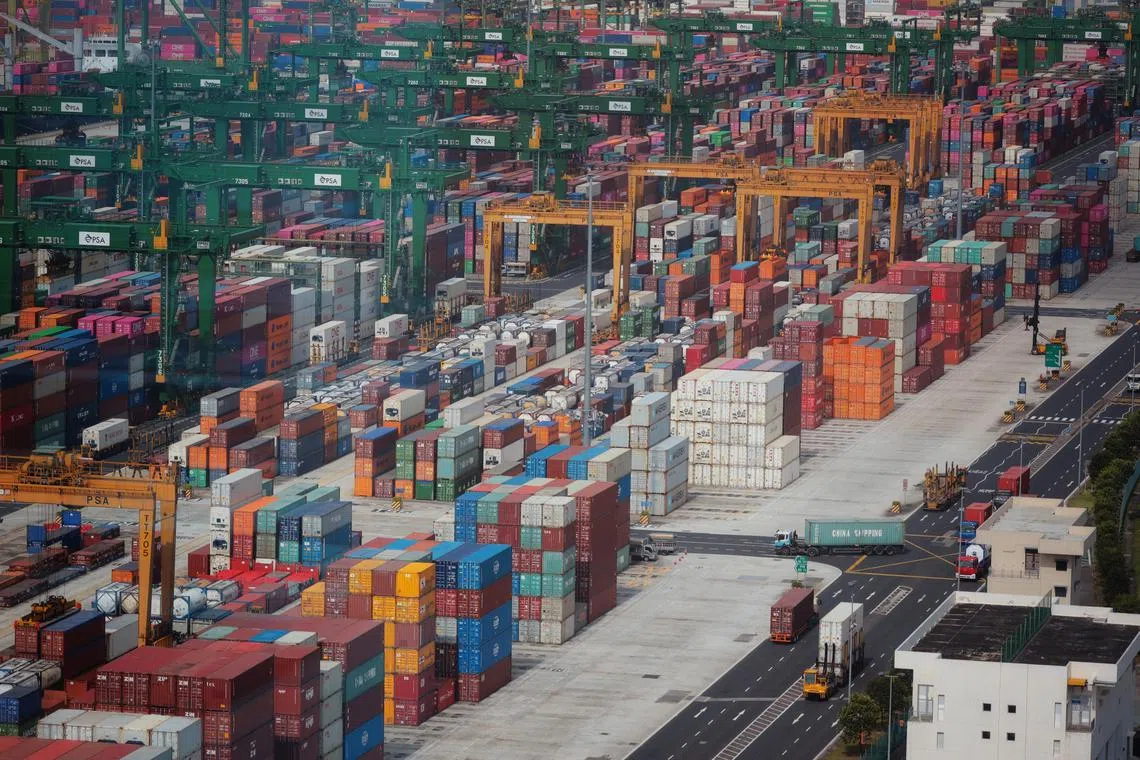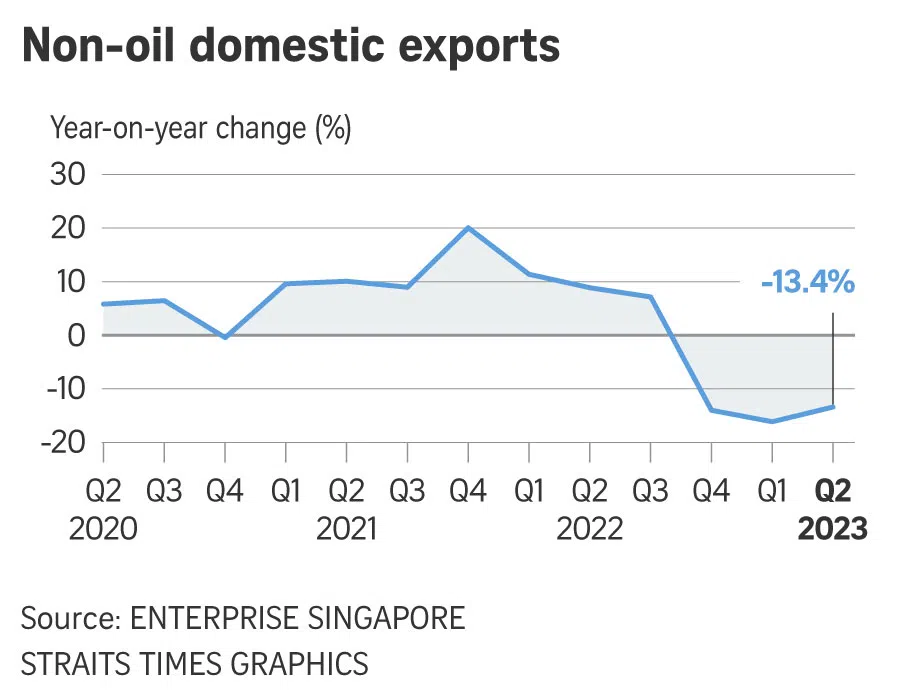Singapore lowers 2023 trade forecast again after Q2 exports sink further
Sign up now: Get ST's newsletters delivered to your inbox

Both key non-oil domestic exports and total merchandise trade are now expected to contract by 9 per cent to 10 per cent.
PHOTO: ST FILE
Follow topic:
SINGAPORE - Singapore has cut again its 2023 growth forecasts for key non-oil domestic exports (Nodx) and total merchandise trade, which includes oil, as the downturn in the global electronics demand continues to weigh on the manufacturing sector of trading partners.
Both Nodx and total merchandise trade are now expected to contract by 9 per cent to 10 per cent in 2023, due to a worse-than-expected performance to date, weighed down by the manufacturing down cycle and lower oil prices, Enterprise Singapore (EnterpriseSG) said on Friday.
In the previous forecast in May,
The latest projection comes after non-oil trade declined by 15.3 per cent year on year to $236.9 billion and total merchandise trade fell by 18.7 per cent to $290.8 billion in the second quarter of 2023, extending the 7.8 per cent fall in the first quarter of 2023.
Oil trade – which formed 19 per cent of total merchandise trade in the second quarter – contracted by 30.9 per cent year on year.
According to the US Energy Information Administration, oil prices averaged US$78 a barrel in the quarter, down from US$114 a barrel in the same quarter a year ago.
On a year-on-year basis, Nodx fell by 13.4 per cent to $44.6 billion in the second quarter, following a 16.1 per cent contraction in the previous quarter.
Exports of electronic products – which accounted for 21 per cent of Nodx in the second quarter – contracted by 22.1 per cent year on year. The decline was led by integrated circuits, personal computers and their parts.
Exports of non-electronic products – which accounted for the remaining 79 per cent of Nodx – declined by 10.7 per cent year on year, dragged by petrochemicals, primary chemicals and specialised machinery. Non-electronics Nodx fell year on year for the third straight quarter, while electronics Nodx dropped for the fourth consecutive quarter.
EnterpriseSG said the external demand outlook for the rest of 2023 remains weak, with the International Monetary Fund (IMF) projecting global economic growth to slow to 3 per cent in 2023 from 3.5 per cent in 2022.
Most of Singapore’s key trade partners including the United States, euro zone and the rest of Asean-5 are expected to grow at a slower pace in 2023, except China and Japan, it said, adding that the IMF is expecting slower global trade growth of 2 per cent in 2023 compared with 5.2 per cent growth in 2022.
Asean-5 comprises Indonesia, Malaysia, Thailand, the Philippines and Singapore.
Except for the US and the European Union, domestic exports to major markets fell year on year in the second quarter. The decline was led by Malaysia, Taiwan and Indonesia.
EnterpriseSG said: “Domestically, manufacturing companies remained cautious due to ongoing global economic uncertainties, even as business sentiments in the sector are slightly positive for the second half of 2023.
“The downturn in the global electronics sector is expected to impact electronics exports, while the outlook for the petrochemicals sector remains sluggish due to planned plant maintenance shutdown, and weak demand would weigh on Nodx. Lower expected oil prices in 2023 could also weigh on our oil trade in nominal terms, and in turn total trade.”
On a quarter-on-quarter seasonally adjusted basis, Nodx increased by 2.3 per cent in the second quarter, after the 3.2 per cent fall in the previous quarter.
Electronics Nodx grew by 2.7 per cent, after falling 8.1 per cent in the first quarter. Non-electronics Nodx rose by 2.2 per cent, after the 1.8 per cent decrease in the first quarter.
Stripping out seasonal fluctuations from the data, Singapore’s economy expanded by 0.1 per cent in the second quarter compared with the previous quarter, a reversal from the 0.4 per cent contraction in the first quarter of 2023.
On a year-on-year basis, the economy grew by 0.5 per cent, extending the 0.4 per cent growth in the first quarter.
Mr Euben Paracuelles, chief Asean economist at Nomura, told The Straits Times the downgrade in forecast was not surprising. Nomura is expecting Singapore’s trade performance for 2023 to come in at the lower end of the new range.
“While we think the electronics cycle is bottoming, external demand will likely remain weak as we still expect the United States to go into a mild recession in the fourth quarter and China’s recovery hasn’t been strong despite the reopening,” he said.
He added: “As a result, we still think Singapore’s gross domestic product growth in the second half will remain subdued. Services will eventually follow weak manufacturing and this synchronisation should hold given the extent of the global growth downturn.”
Ms Selena Ling, chief economist and head of treasury research and strategy at OCBC, said manufacturing remains the weakest link for the economy due to the drag from the electronics and precision engineering clusters as a result of the prolonged global electronics downturn and the rivalry between the US and China.
She is keeping her 2023 Nodx forecast at around a 10 per cent year-on-year contraction.
Despite the Government’s downgrade in trade outlook, Dr Chua Hak Bin, regional co-head of macro research at Maybank, believes the manufacturing and electronics downturn is past its worst.
“Falling and lower commodity and goods prices are camouflaging the strength and pickup in regional trade activity and volumes. We have to distinguish the volume and price effects which are driving exports and trade in opposite directions,” he said.

Moreover, there are signs of a pickup in regional trade volumes, as reflected by the sharp increase in container throughput and total sea cargo handled here, as well as the turnaround in Singapore’s wholesale trade services sector.
Dr Chua reckons that while China’s reopening has fallen short of expectations, it could provide some small boost to trade and exports. China’s trade data reported a 13.8 per cent increase in import volumes in July, even as import values fell by 12.4 per cent year on year due to falling prices, he said.
He expects the US manufacturing investment and construction boom to spur import demand later in 2023, which could benefit exports from Singapore and the region as new factories will eventually have to be refitted with new machinery equipment and components.


